
Playlists
 |
Playlist Playlists |
| I mille volti della seduzione The many faces of seduction |
|
| Nota: E' disponibile una versione pdf di questo Dossier. |
Note: A
pdf version
of this Dossier is available. |
|
Versione italiana English version |
|
| E' entrata nell'immaginario collettivo la figura di Benjamin, studente ventunenne che, appena finito il college, viene abbordato e sedotto dalla Signora Robinson, amica di famiglia e madre della ragazza di cui Ben si innamorerà. Ben è certamente "inesperto" e molto confuso su di sè e sul suo futuro, ma sa riconoscere le mosse della signora (di cui diviene l'amante). Nel 1967 questa storia sembrò scuotere l'America perbenista e puritana, e, col senno di poi, anticipava quella "contestazione generale" che di lì a poco sarebbe esplosa in Europa e in America, con le lotte per la libertà sessuale e femminista, contro il capitalismo e per la fine della guerra nel Vietnam. (anche se la storia di Ben è però molto "privata"). Famosissima la colonna sonora di Simon & Garfunkel, con la canzone Mrs Robinson diventata un successo mondiale, così come la battuta con cui si conclude questa sequenza: "Signora Robinson, lei sta tentando di sedurmi, non è vero". Qualche curiosità: Dustin Hoffman, la cui carriera venne lanciata da questo film, interpretava un "ragazzino", mentre aveva già 30 anni - e Anne Bancroft, la matura Signora Robinson, aveva solo sei anni più di lui. E la gamba che compare alla fine della sequenza (e che fa da cornice - o da trappola? - alla figura di Ben) e che venne riprodotta nei manifesti dell'epoca, era in realtà della modella Linda Gray, poi diventata celebre per la sua interpretaazione di Sue Ellen nella fortunatissima serie televisiva Dallas. |
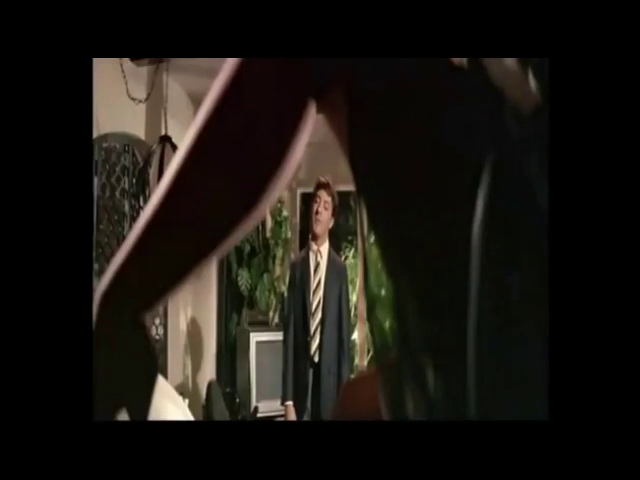 Il laureato/The graduate (di/by Mike Nichols, USA 1967) |
The character of Benjamin, a twenty-one-year-old student who has just finished college, has entered the collective imagination, as well as that of Mrs Robinson, a friend of his family and mother of the girl he will soon fall in love with. The sequence which opens our playlist sees Ben seduced by Mrs Robinson - and, although Ben is certainly "inexperienced" and very confused about himself and his future, he knows how to recognize what the lady is doing - and quickly becomes her lover. In 1967 this story seemed to shake the respectable and Puritan America, and, in hindsight, it anticipated the protest that would shortly explode in Europe and America, with struggles for sexual and feminist freedom, against capitalism and for the end of the Vietnam war (although Ben's story is, in a way, very "private"). Simon & Garfunkel's soundtrack became an instant hit, and the song "Mrs Robinson" a worldwide success. Ben's line which ends this sequence ("Mrs. Robinson, you're trying to seduce me. Aren't you?") still ranks among the best-remembered of cinema's history. Some curiosities: Dustin Hoffman, whose career was launched by this film, played a "boy", although he was already 30 years old - and Anne Bancroft, the mature Mrs. Robinson, was only six years older than him. And the leg that appears at the end of the sequence (and that frames Ben's figure, and which was reproduced in the posters of the time, actually belonged to Linda Gray, a famous model who later became famous for her Interpretation of Sue Ellen in the very successful television series Dallas. |
| Chi non ricorda le intramontabili interpetrazioni di Tony Curtis e Jack Lemmon, in panni femminili, accanto ad un'affascinante Marilyn Monroe? Ma Curtis nel film si traveste doppiamente: finge di essere un miliardario (nientemeno che il proprietario della Shell petroli!) per conquistare Marilyn. La porta di nascosto su un lussuoso yacht e adotta una tecnica di seduzione raffinata: dice di avere problemi con le donne e di aver tentato varie cure senza successo. Inutile dire che Marilyn si prodigherà per "guarirlo" ... in una sequenza con cui il furbo Billy Wilder sa prendersi gioco delle convenzioni e dei doppi sensi ... |
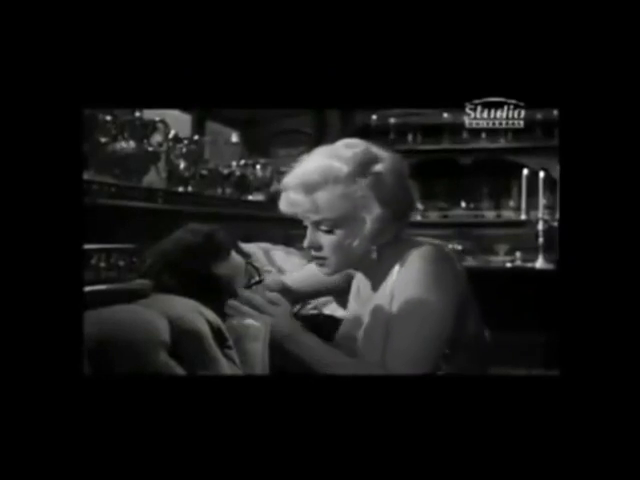 A qualcuno piace caldo/Some like it hot (di/by Billy Wilder, USA 1959) |
Who does not remember the timeless interpretrations of Tony Curtis and Jack Lemmon, dressed-up as women, next to a fascinating Marilyn Monroe? But Curtis in the film disguises himself doubly: he pretends to be a billionaire (none other than the owner of Shell Oil Company!) to conquer Marilyn. He tyakes her onto a luxurious yacht and adopts a refined seduction technique: he says he has problems with women and has tried various treatments without success. Needless to say, Marilyn will do her best to "heal" him ... in a sequence in which clever Billy Wilder knows how to make fun of conventions and double entendre ... |
| Di tutt'altra natura la seduzione operata da Jennifer Beals nel film, diventato poi un piccolo cult, Flashdance, storia (o fiaba ...) di un'operaia che sogna di diventare ballerina e nei suoi testardi tentativi riesce anche a trovare l'amore. In questa sequenza, la ragazza conversa con l'uomo di fronte a lei, ma mentre non smette di parlare del più e del meno si toglie il reggiseno (e poi, di sfuggita le mutandine), con tutta una serie di movimenti molto naturali sotto il maglione, che mandano però segnali inequivocabili ad un amante un po' refrattario ... |
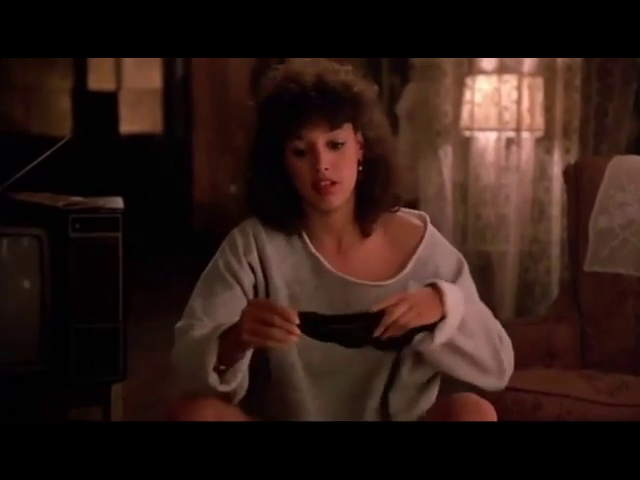 Flashdance (di/by Adrian Lyne, USA 1983) |
Of a completely different nature
is
the seduction by Jennifer Beals in Flashdance, which became a small cult film, the story (or, rather, a fairy tale ...) of a worker who dreams of becoming a dancer and in her stubborn attempts also manages to find love. In this sequence, the girl keeps talking to the man in front of her, but in the meantime removes her bra, with a whole series of very natural movements underneath her sweater, thus sending unequivocal signals to a somewhat puzzled potential lover ... |
| La terza trasposizione cinematografica di un famoso romanzo di James Cain, dopo una prima del 1939 e una seconda (Ossessione, vedi la prossima sequenza), utilizza le convenzioni del film noir già ben diffuse, ma con una dark lady (Lana Turner) che affascina e immediatamente seduce il nuovo arrivato (John Garfield), con pochi tocchi magistrali e pur senza ricorrere ad un realismo erotico vietato dal codice censorio allora imperante. L'eros è più evocato che mostrato, ma la sensualità della Turner ha reso questa sequenza intramontabile. Nelle parole del Mereghetti (Dizionario dei film, Baldini e Castoldi, Milano): "bastano un rossetto, un paio di caviglie, una succinta mise bianca -completata da un asciugamano a mo' di turbante - per materializzare un'autentica dark lady e mettere in moto un intrigo di eros e thanatos senza via di scampo". |
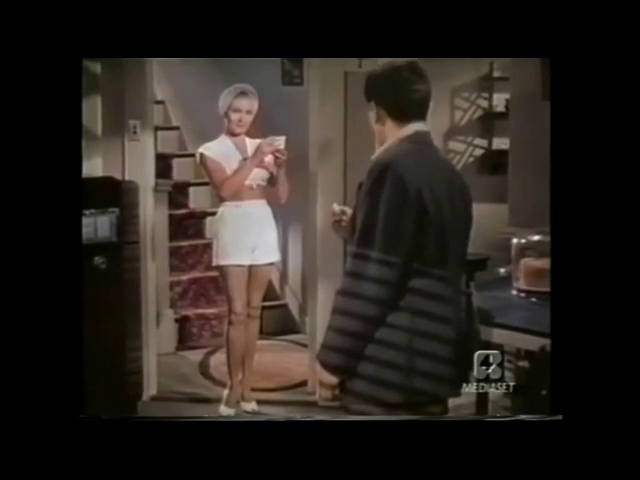 Il postino suona sempre due volte/The postman always rings twice (di/by Tay Garnett, USA 1946) |
The third cinematographic adaptation of a famous novel by James Cain, after the first in 1939 and a second (Ossessione, see the next sequence), uses the already widespread conventions of film noir, but with a dark lady (Lana Turner) who lures and immediately seduces a newcomer (John Garfield) - and all this with a few masterful touches and even without resorting to an erotic realism which was prohibited by the then prevailing censorship code. Eros is more evoked than shown, but Turner's sensuality has made this sequence timeless. As Mereghetti (Dizionario dei film, Baldini and Castoldi, Milan) wrote: "A lipstick, a pair of ankles, a scanty white outfit - and a white towel fashioned as a turban - are enough to materialize an authentic dark lady and set in motion an intrigue of Eros and Thanatos with no way out ". |
| Considerato da più parti come il film apripista del neorealismo, Ossessione mette in scena la stessa storia del film precedente, ambientandolo però nella bassa pianura padana. Il tema audace e perfino scabroso per l'epoca, e il ruolo giocato dal contesto socio-culturale, giustificano il carattere neorealista, ma il tono con cui si consuma e si brucia questa passione amorosa ed erotica è compensato da una messa in scena che punta sullo squallore dell'ambiente - anche se sequenze come questa trasmettono in pieno, senza retorica ma anzi in modo volutamente "raffreddato", una passione decisamente concreta tra due amanti travolti dal destino (Clara Calamai e Massimo Girotti). Ed è magistrale il modo in cui l'uomo viene attirato dal canto della donna come da una (inconsapevole?) sirena. |
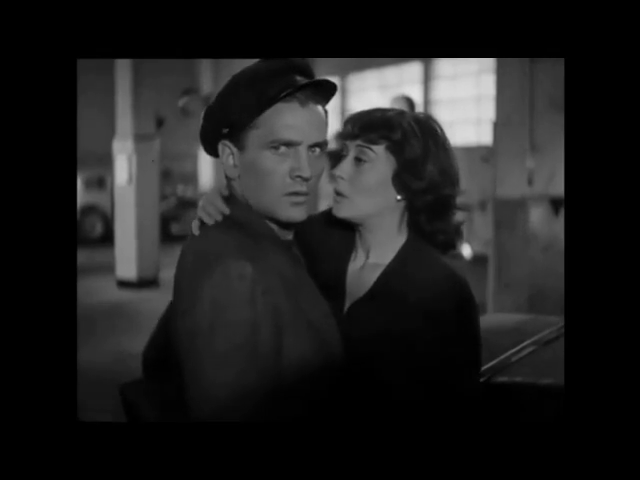 Ossessione (di/by Luchino Visconti, Italia 1943) |
Considered by many as the forerunner of neorealism, Ossessione stages the same story as the previous film, but setting it in the Po Valley in nothern Italy. The bold and (for the time) controversial theme, and the role played by the socio-cultural context, justify the neorealist treatment, but the tone with which this erotic passion is consumed is compensated by a staging that focuses on the bleakness of the environment - even if sequences like this clearly convey, without a hint of rhetoric but with a deliberately "cool" touch, a decidedly concrete passion between two lovers overwhelmed by fate (Clara Calamai and Massimo Girotti). And the way in which the man is lured by the singing of the woman - as if by an (unaware?) siren - is still masterful. |
| Cambiano i tempi, cambia il modo di rappresentare l'erotismo e la sensualità, e la quarta versione della stessa storia vede ora per protagonisti Jessica Lange e Jack Nicholson. Le scene di sesso sono ora molto più esplicite (e violente), ma rimane il tono realistico della messa in scena (siamo pur sempre negli anni '30 della Grande Depressione americana), che evita gli stereotipi del noir per lasciar spazio a personaggi ben definiti. Questa sequenza si conclude con la scena (diventata presto cult) del rapporto consumato sul tavolo della cucina, tra pagnotte e farina ... |
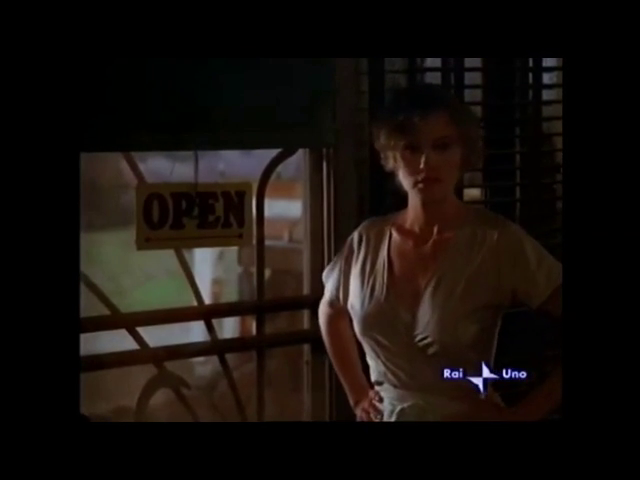 Il postino suona sempre due volte/The postman always rings twice (di/by Bob Rafelson, USA 1981) |
Times change, the way of representing eroticism and sensuality changes, and the fourth adaptation of the same story now features Jessica Lange and Jack Nicholson as main characters. The sex scenes are now much more explicit (and violent), but the realistic tone of the staging remains (we are still in the 1930s of the great American depression), avoiding noir stereotypes in favour of well-defined characters. This sequence ends with the scene (which soon became a cult one) the man and te woman making love on the kitchen table ... |
| Con la fine del '900 e l'inizio del nuovo millennio, anche le storie di seduzione gay trovano una rappresentazione onesta e realistica, lontana dai clichè e dalle mistificazioni di tanto cinema precedente. In questo caso la seduzione è indiretta e raffinatissima, orchestrata da una ricca ed elegante signora (Cate Blanchett) nei confronti di una modesta commessa di grandi magazzini (Rooney Mara). Tutto avviene al tavolo di un ristorante di lusso, durante una conversazione in cui la signora mantiene sempre il controllo del rapporto, cominciando con le domande rivolte alla ragazza e svelando solo molto gradualmente il suo interesse ... |
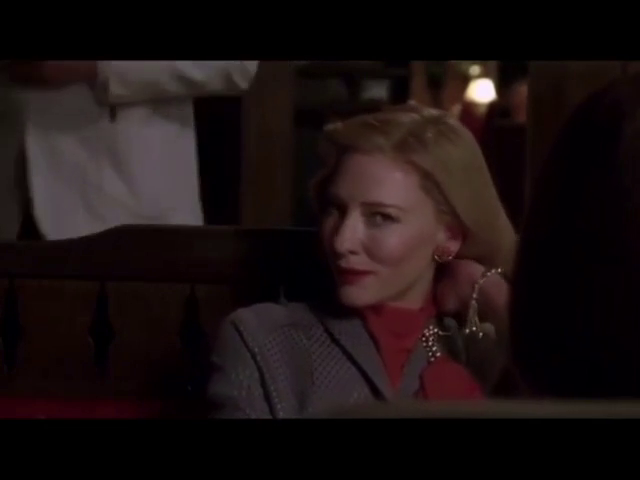 Carol (di/by Todd Haynes, GB/USA 2015) |
In the late 1990s and the beginning of the new millennium, the stories of gay seduction also find an honest and realistic representation, far from the clichés and mystifications of a lot of previous cinema. In this case, the seduction is indirect and very refined, orchestrated by a rich and elegant lady (Cate Blanchett) against a modest saleswoman working in a department store (Rooney Mara). Everything happens at the table of a luxury restaurant, during a conversation in which the lady always maintains control of the relationship, starting with the questions addressed to the girl and only gradually revealing her interest ... |
| Torniamo all'inizio degli anni '50 del secolo scorso per una nuova storia di amore e morte. Il regista Otto Preminger dirige una storia di seduzione e di epilogo drammatico che ha per protagonisti una ragazza di buona famiglia (Jean Simmons) che irretisce un autista di ambulanze (Robert Mitchum), prima mandando a monte i progetti dell'uomo con la sua attuale fidanzata, e poi prendendo decisamente in mano la situazione, invitandolo a cena e a ballare. L'uomo, come succede spesso in questi casi, viene prontamente sedotto, ma faticherà a rendersi conto del carattere manipolatorio e del furore (auto)distruttivo della ragazza, che lo porterà all'omicidio e alla tragedia finale. Il sesso per Preminger è qui una brutale forza che finisce per accecare la responsablità individuale, con Mitchum nei panni di un perdente che viene trascinato, passo dopo passo, vero un destino fatale già segnato in partenza. |
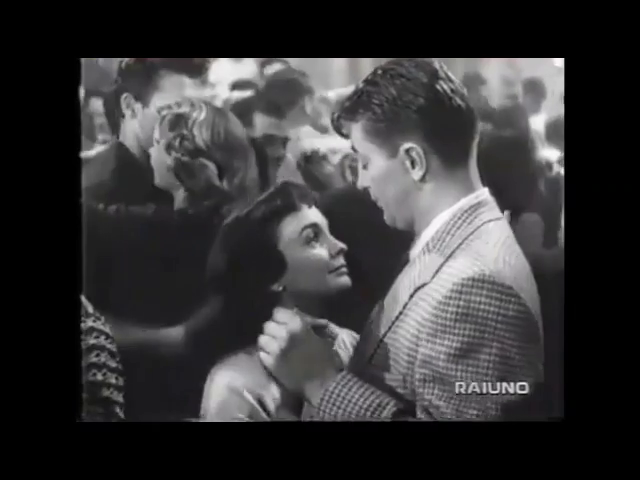 Seduzione mortale/Angel face (di/by Otto Preminger, USA 1953) (The sequence is missing from the English version due to copyright issues) |
|
| Già nel 1930, quando le dark ladies del cinema noir erano ancora di là da venire, von Sternberg creava con Marlene Dietrich un'icona femminile di assoluto cult, un'immagine di donna che spazzava via con la sua carica erotica sensualissima ed il suo cinismo tutto il decoro borghese di una società in via di mutamento profondo. "Io sono, dalla testa ai piedi, fatta per l'amore, perchè tale è il mio mondo, e nient'altro che questo. E' quel che devo fare, è la mia natura, posso solo amare, e nient'altro che questo. Gli uomini mi svolazzano intorno come falene ad una luce, e, pure se si bruciano, non posso farci niente ..." canta Marlene, sprezzante e conturbante, a cavalcioni di una sedia sul palcoscenico del locale noto come "L'angelo azzurro". Questo amore assoluto, questa forza della natura, farà le sue vittime, a cominciare dal povero e stimato professore di ginnasio (che vediamo già in questa sequenza umiliarsi di fronte alla presenza magnetica della donna), che finirà per sposarla e diventarne succube perdendo ogni senso morale e ogni dignità umana. |
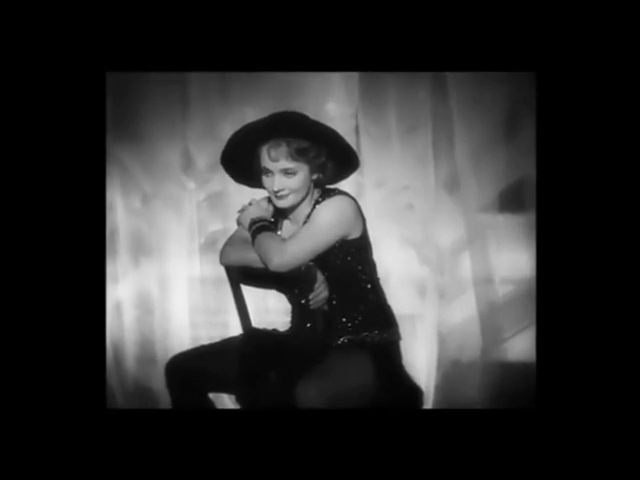 L'angelo azzurro/Der blaue Engel/The blue angel (di/by Josef von Sternberg, Germania/Germany 1930) |
Already in 1930, when the Dark Ladies of film noir were still to come, Von
Sternberg created a women's icon of absolute cult with Marlene Dietrich,
an image of a woman who swept away with her very sensual erotic charge
and her cynicism all the bourgeois decorum of a society in the
process of dramatic change. "I am, from head to feet, made for love,
because such is my world, and nothing more than this. It is what I have
to do, it is my nature, I can only love, and nothing but this. Men
flutter around me like moths around a light, and, even if they burn, I
can't do anything ..." sings Marlene, contemptuous and disturbing, riding a chair on the stage of the
nightclub known as "The blue angel".
This absolute love, this force of nature, will make its victims,
starting with a professor (whom we
already see in this sequence humiliating himself in front of the
magnetic presence of the woman), who will end up marrying her and losing
all his moral and human dignity. |
| L'infatuazione di un distinto professore per una ninfetta adolescente è al centro del romnanzo di Vladimir Nabokov, portato sullo schermo da Kubrick nel 1962, con un prevedibile scalpore per il tema "scottante". In questa sequenza, il professore (James Mason), alla ricerca di una camera da affittare, visita una casa e ne discute con la padrona (Shelley Winters). E rimane turbato e affascinato dalla ragazzina che, stesa sul prato del giardino con un lecca-lecca a forma di cuore, lo fissa subito con sguardo ammiccante. E l'ingenua padrona gli chiede che cosa lo ha fatto decidere di affittare proprio una camera in quella casa ... il prezzo pattuito? la torta di mele specialità della casa? ... Non è che il primo passo verso un destino di degrado, umiliazione e autodistruzione ... |
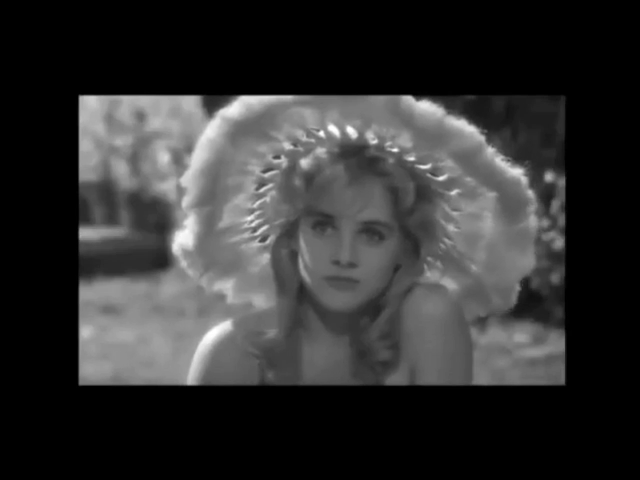 Lolita (di/by Stanley Kubrick, GB 1962) |
The infatuation of another professor for a teenage nymph is the focus of Vladimir Nabokov's novel, Lolita, brought to the screen by Kubrick in 1962. In this sequence, the professor (James Mason), looking for a room to rent, visits a house and meets the landlady (Shelley Winters). He is immediately disturbed and fascinated by the girl who, lying in the garden with a heart-shaped lollipop, stares at him with a winking gaze. And the naive landlady asks him what made him decide to rent a room in her house ... the cheap price? The apple pie, a specialty of the house? ... This is just the first step towards a fate of degradation, humiliation and self -destruction ... |
| Un destino per certi versi simile attende uno sprovveduto assicuratore (Fred MacMurray), che incontra la moglie di un suo cliente (Barbara Stanwyck) e ne rimane affascinato: quando la donna scende le scale, e la macchina da presa inquadra la catenella che porta alla caviglia, in una scena di alta tensione erotica, sappiamo già che per l'uomo non c'è via di scampo. In uno dei primi veri film noir (da una romanzo di James M. Cain sceneggiato dall'altrettanto famoso Raymond Chandler), la figura della femme fatale è già pienamente illustata: bellissima ma distruttiva, un misto di ambizione, ferocia e totale mancanza di senso morale, questo tipo di donna, che non ha dubbi sull'uso della violenza fino all'omicidio, è il vero movente della storia e la trappola mortale in cui gli uomini non possono che soccombere in un destino fatale già segnato in partenza. |
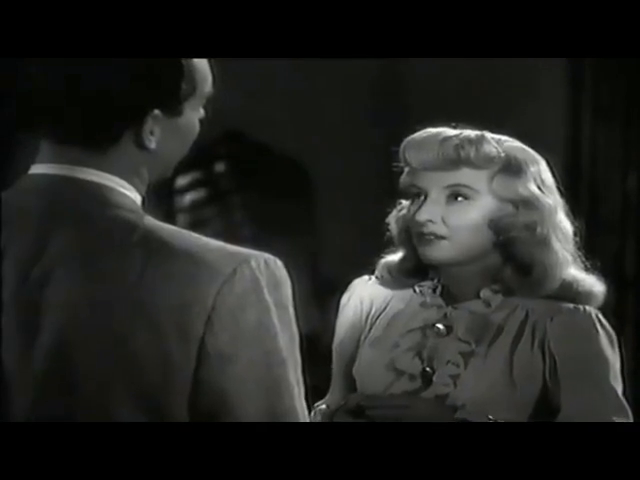 La fiamma del peccato/Double indemnity (di/by Billy Wilder, USA 1944) |
A similar fate awaits an unwary insurer (Fred Macmurray), who meets one of his clients' wife (Barbara Stanwyck) and is fascinated by her the moment she descends the stairs, with the camera framing the chain around her ankle: in this scene of high erotic tension, we already know that there will be no way out for the man. In one of the first real films noir (from a novel by James M. Cain adapted for the screen by the equally famous Raymond Chandler), the figure of the femme fatale is already fully developed: beautiful but destructive, a mixture of ambition, ferocity and total lack of moral sense, this type of woman, who has no hesitations about the use of violence and murder, is the true driving motive of the story: men can only succumb to the deadly trap set for them as their fate is already decided right from the start. |
| Terminiamo la nostra playlist con una delle scene di seduzione più tese e originali della storia del cinema: una seduzione sottile, senza dialoghi, operata ad un tavolo da gioco da un ambiguo arrivista e approfittatore senza scrupoli (Ryan O'Neal) nei confronti della padrona di casa, l'infelicemente sposata Lady Lyndon (Marisa Berenson), con l'intento di sposarla alla morte del marito per ereditarne la fortuna e, soprattutto, il titolo nobiliare. Questa sequenza è rimasta famosa per la la forza della seduzione che si sprigiona solo attraverso gli sguardi: l'uomo fissa la donna, fino a farla sentire così imbarazzata e turbata da farle lasciare la sala. L'uomo la segue, non lascia tregua alla sua preda finchè alla donna non resta che capitolare. Il tutto senza dialoghi ma con delicati sottofondi musicali. La sequenza è rimasta famosa anche per la luce naturale utilizzata (candele e lampade ad olio), che ha richiesto l'uso di speciali obiettivi, in origine sviluppati dalla Zeiss per i satelliti della NASA. |
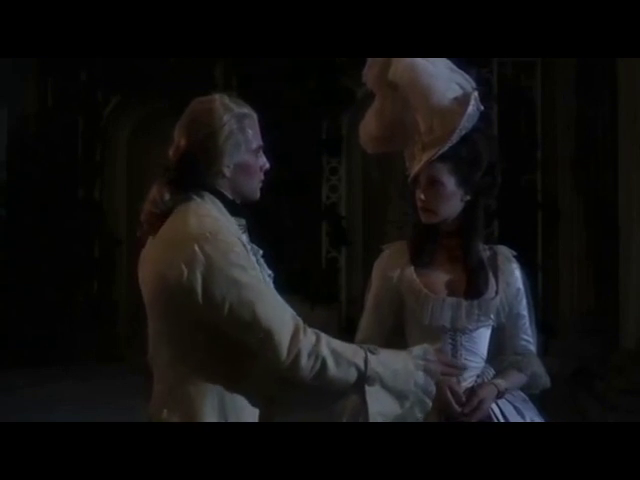 Barry Lyndon (di/by Stanley Kubrick, GB 1975) |
We end our playlist with one of the most tense and original seduction scenes in the history of cinema: a subtle seduction, without dialogues, by an ambiguous and unscrupulous social climber (Ryan O'Neal) against the unhappily married Lady Lyndon (Marisa Berenson), with the scheme to marry her after the death of her husband so as to inherit her fortune and, above all, her noble title. This sequence has remained famous for the strength of the seduction that only uses glances across the table: the man stares at the woman, until this makes her feel so embarrassed and disturbed as to make her leave the room. The man follows her until she finally surrenders - no words are spoken as we only hear a musical background. The sequence was also famous for the natural light used by Kubrick(candles and oil lamps), which required the use of special lenses, originally developed by Zeiss for NASA satellites. |
Torna all'inizio della pagina Back to start of page